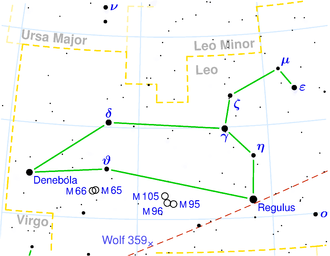NGC 3731
| Galaxie NGC 3731 | |
|---|---|
 | |
| SDSS-Aufnahme | |
| AladinLite | |
| Sternbild | Löwe |
| Position Äquinoktium: J2000.0, Epoche: J2000.0 | |
| Rektaszension | 11h 34m 11,7s[1] |
| Deklination | +12° 30′ 44″ [1] |
| Erscheinungsbild | |
| Morphologischer Typ | E [1][2] |
| Helligkeit (visuell) | 13,1 mag [2] |
| Helligkeit (B-Band) | 14,1 mag [2] |
| Winkelausdehnung | 1,0' × 0,9' [2] |
| Positionswinkel | 50° [2] |
| Flächenhelligkeit | 13,1 mag/arcmin² [2] |
| Physikalische Daten | |
| Rotverschiebung | 0.010421 ± 0.000047 [1] |
| Radialgeschwindigkeit | (3124 ± 14) km/s [1] |
| Hubbledistanz vrad / H0 | (136 ± 9) · 106 Lj (41,7 ± 2,9) Mpc [1] |
| Geschichte | |
| Entdeckung | Wilhelm Herschel |
| Entdeckungsdatum | 12. April 1784 |
| Katalogbezeichnungen | |
| NGC 3728 • UGC 6553 • PGC 35731 • CGCG 068-003 NED01 • MCG +02-30-001 • 2MASX J11341166+1230436 • GC 2448 • H III 80 • | |
NGC 3731 ist eine elliptische Galaxie vom Hubble-Typ E im Sternbild Löwe auf der Ekliptik. Sie ist schätzungsweise 136 Millionen Lichtjahre von der Milchstraße entfernt.
Das Objekt wurde am 12. April 1784 von Wilhelm Herschel entdeckt.[3]
Weblinks
Einzelnachweise
Auf dieser Seite verwendete Medien
Autor/Urheber: Copyright © 2003 Torsten Bronger., Lizenz: CC BY-SA 3.0
This is a celestial map of the constellation Leo, the Lion.
Autor/Urheber: Sloan Digital Sky Survey, Lizenz: CC BY 4.0
The sky image is obtained by Sloan Digital Sky Survey, DR14 with SciServer.
Angle of view: 4' × 4' (0.3" per pixel), north is up.
Details on the image processing pipeline: https://www.sdss.org/dr14/imaging/jpg-images-on-skyserver/



